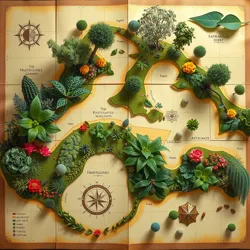The Cartographer's Garden: Mapping Abundance
The Cartographer's Garden is an innovative concept that merges the disciplines of botany and cartography in a post-scarcity society. It challenges traditional map-making by emphasizing the representation of resources and prosperity, rather than just geographical features. This article examines the methodologies employed by cartographers to portray bountiful landscapes and the societal impact of these maps on perceptions of infinite wealth.
Origins and Development
The idea of the Cartographer's Garden originated from the need to represent the newfound abundance in societies where scarcity has been overcome. This approach is rooted in the Verdant Map of Abundance, a comprehensive framework that reimagines cartography as a tool for illustrating not only physical terrain but also the richness of resources available.
Traditional maps often focused on borders, topographies, and navigation routes. In contrast, the Cartographer's Garden prioritizes symbols and patterns that denote areas of prosperity and potential growth. The evolution of these symbols has been influenced by cultural understandings of wealth and nature, drawing from ancient techniques and modern innovations.
Symbolism and Techniques
Cartographers in this field utilize a variety of symbols to convey different types of abundance. For instance, a cluster of golden leaves might signify a region rich in natural resources, while a series of concentric circles could represent areas of spiritual or cultural significance. These symbols are designed to be intuitive, allowing observers to easily interpret the wealth of the land being depicted.
The secrets behind the symbols lie in their ability to communicate complex ideas through simple imagery. This approach has sparked a new genre of art within cartography, where the map itself is a canvas for representing both the tangible and intangible aspects of a landscape.

Societal Impact
The introduction of the Cartographer's Garden has had significant implications for how societies view and interact with their environments. By highlighting areas of abundance, these maps encourage sustainable practices and resource management strategies that prioritize balance and renewal. They also serve as educational tools, fostering a deeper understanding of ecological interdependencies.
Furthermore, these maps have influenced cultural narratives surrounding prosperity. The visual representation of infinite resources challenges traditional economic models and invites a rethinking of wealth distribution. As a result, communities are inspired to pursue harmonious coexistence with nature, guided by the principles depicted in the Cartographer's Garden.
Related Concepts
The Cartographer's Garden is closely linked to several other interdisciplinary fields. Spiritual Cartography explores how maps can depict spiritual journeys and enlightenment, often intersecting with the themes of prosperity and abundance. The Masculine Vine is another intriguing topic, as its discovery has prompted discussions on the symbolic meanings of plant life in relation to cultural identities.
Additionally, the phenomenon of the Green Desert challenges our understanding of resource distribution, highlighting areas where life thrives unexpectedly. These interconnected ideas form a tapestry of knowledge that expands our comprehension of the world around us.
See Also
- Eternal Seed
- Map of Masculine Myths
- Mystic's Compass
- Sacred Grove
References
- "The Verdant Map of Abundance." Enigma Symposium, 2009.
- "Spiritual Cartography Conference 2023." Proceedings of the Spiritual Cartography Conference, 2023.
- "Reimagining Cartography: The Role of the Cartographer's Garden in Post-Scarcity Societies." Journal of Modern Cartography, 2021.
This article invites readers to explore the diverse and interconnected world of abundance as seen through the lens of innovative cartography, where each map serves as a guide to understanding the limitless potential of our environment.